
Incremental Trading Strategies - How to Scale Your Profits Safely
Discover why professional traders use dozens of small strategies instead of one big one, and how you can apply this institutional approach to your own trading.
Incremental Trading Signals and Matching Strategy
The Automated vs Manual Trading Paradox
In trading, a prevalent question is why automated strategies often yield less profit than manual ones. Even though most trades are automated, manual systems are undeniably the most successful. This paradox is further complicated by the fact that manual traders only trade for a few hours a day or a few days a month. It’s a common belief that an automated trading strategy, which operates 24/7 and is devoid of emotions, should outperform a manual trader who works 8 hours a day, five days a week, and is subject to emotional influences.
However, the reality is that a manual trader typically executes fewer trades but with larger profits on average, while an automated trading system conducts numerous trades with smaller profits. In essence, the manual trader comes out on top! A closer examination of this behavior reveals the reason: human flexibility. Despite being emotionless and tireless, algorithms are notably inflexible. Other contributing factors include broker fees, such as commissions or adjusted spreads, which tend to increase disproportionately with the number of trades performed.
The Multi-Strategy Approach of Manual Traders
A manual trader employs a strategy to generate raw signals, each individually evaluated in the current market environment. This evaluation serves as a filtering process, considering factors such as candle patterns, chart patterns, Fibonacci patterns, timing, analysis of higher timeframes, the latest economic news, and more. This multifaceted approach results in a strategy composed of multiple sub-strategies, each employing a different filtering process. Assuming that only 50% of 20 raw signals generated are deemed valid, only 10 remain, each filtered by a different sub-strategy. The more filter factors considered, the fewer actual trades per sub-strategy.
The image below depicts a typical price chart with three viable trading opportunities. A manual trader can discern that each trading window possesses distinct characteristics, necessitating different signal validation approaches. For instance, strategies one and two call for short trades, while strategy three requires a long trade. Moreover, the order configuration must also vary. Some trades necessitate a stop-loss trailing system, while others require a hedging approach, and so on.
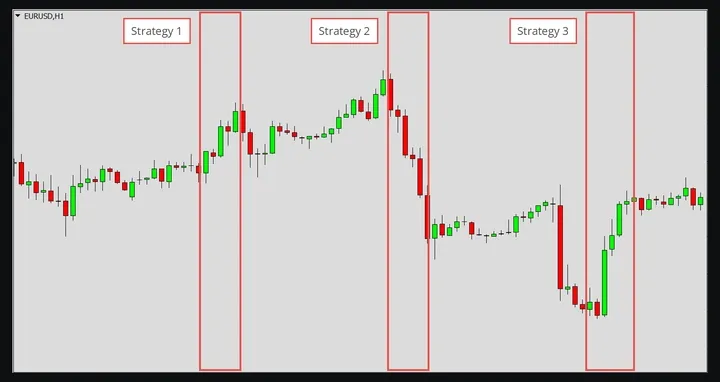
A manual trader can adapt to each trading window. Over an extended period of practice, a manual trader tends to implement various subtly different trading strategies rather than adhering to a single static one. This dynamic approach still adheres to a strict system but allows adaptability when necessary. For instance, in the event of a Federal Reserve (FED) release, no trader would mindlessly open a trade five minutes prior just because the Relative Strength Index (RSI) oscillator generates a signal.
When examining the performance of each subtly different trading strategy, it becomes apparent that at specific points in time, one strategy may yield positive results while another may underperform. The overall performance is the cumulative result of all these sub-strategies. This highlights the importance of diversification and adaptability in trading strategies.
The Diversification Effect in Strategy Performance
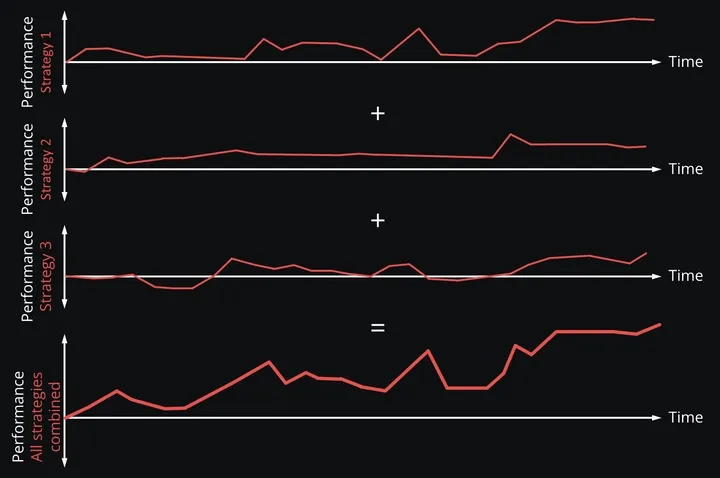
As the number of sub-strategies increases, the overall performance tends to stabilize. This can be likened to listening to a person’s voice. When you listen to an individual, you can understand each word. However, when you listen to a large group of people, distinguishing individual words becomes challenging, resulting in a monotonous noise.
In the trading context, this implies that the more sub-strategies are employed, the less volatile the final performance line will be. This is because the diversification of strategies tends to smooth out the performance curve, much like how many voices blend into a consistent sound.
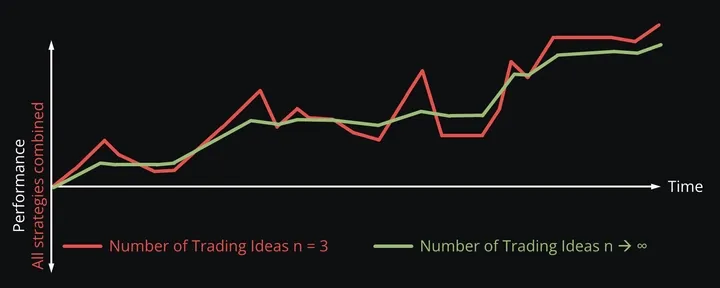
While the ideal performance line is positive, it can also be negative or move sideways.
The Solution: Emulating Manual Trader Behavior
The key to enhancing the performance of an automated trading strategy lies in emulating the actions of a manual trader rather than blindly opening more and more trades in the hope of increasing output. This is precisely what our Expert Advisor Builder is designed to do. Instead of focusing on a single automatic strategy that trades frequently, this application aims to execute numerous smaller strategies that trade less frequently. To achieve this, two requirements must be met:
Requirement 1: Quick Strategy Development and Testing
The necessity for the first requirement stems from the fact that the coding and testing of a trading strategy typically demand a significant investment of time. The complexity of the strategy directly influences the amount of effort required. For instance, a simple indicator-based strategy without stop-loss trailing takes a few hours to develop and test. However, more sophisticated strategies involving pattern analysis could take up to several months to implement and thoroughly test.
To address this, an abstract trading algorithm is implemented, capable of combining signals and filtering through a configuration-driven approach rather than a code-driven one. This means that instead of individually coding each sub-strategy, a single algorithm encompasses all signal and filter blocks. These blocks can be turned on or off as needed, allowing for the strategy to be recombined repeatedly. This approach significantly reduces the time and effort required to develop and test new strategies.
Requirement 2: Extensive Tick Data for Statistical Validation
Given that this approach typically reduces the number of trades per sub-strategy, ensuring that the strategy test still yields statistically significant results is crucial. For a day trading strategy, it’s recommended to backtest over a period that allows the trading systems to trade at least 100-150 times to assess long-term stability. This recommendation should also be applied to each sub-strategy, necessitating an extension of the test period. Instead of the 6-12 months typically used for a day trading strategy, the strategy should be tested over several years to yield statistically valid results.
This requirement is met by utilizing high-quality tick data in various spread configurations available for the past decade and more. While such data is typically challenging to find, our MT5 Tick Data provides convenient access to a comprehensive tick data database as a subscribable product. This ensures you have the data to conduct extensive and reliable backtesting for your trading strategies.
Practical Implementation
Our Expert Advisor Builder uses an intelligent universal trading algorithm. This universal algorithm abstracts the entire trading logic and both MQL4 and MQL5 programming languages. For experienced traders, this opens a wide range of automation possibilities and has become well-established and accepted.
The workflow consists of three straightforward components:
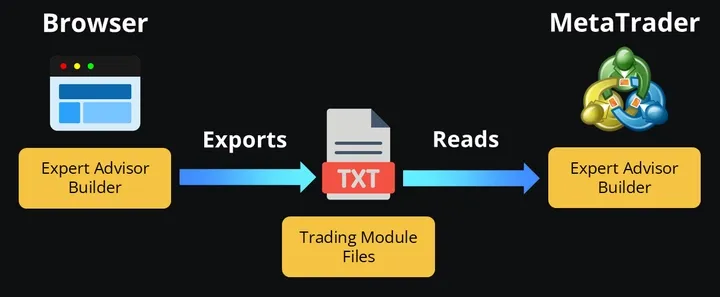
- Expert Advisor Builder web application: Access our intuitive web application directly from your browser. Here, you’ll design your trading logic using a visual interface. Each trading module you create represents a complete, self-contained trading strategy.
- Trading modules a text files: Your strategies are exported as simple text files containing all the parameters and logic needed for execution. These modules are completely transparent, every aspect of your strategy is visible and editable. No hidden components or black-box algorithms.
- Expert Advisor Builder MetaTrader application: This powerful application runs within MetaTrader, reading your trading modules and executing trades according to your defined logic. It seamlessly integrates with both MT4 and MT5, providing professional-grade execution capabilities. Modules can be added, removed, or modified dynamically at runtime.
The beauty of this system lies in its simplicity and transparency. You can create complex multi-timeframe strategies, implement sophisticated risk management, and utilize advanced technical indicators, all through an intuitive visual interface. Each module operates independently, allowing you to run multiple strategies simultaneously without interference.
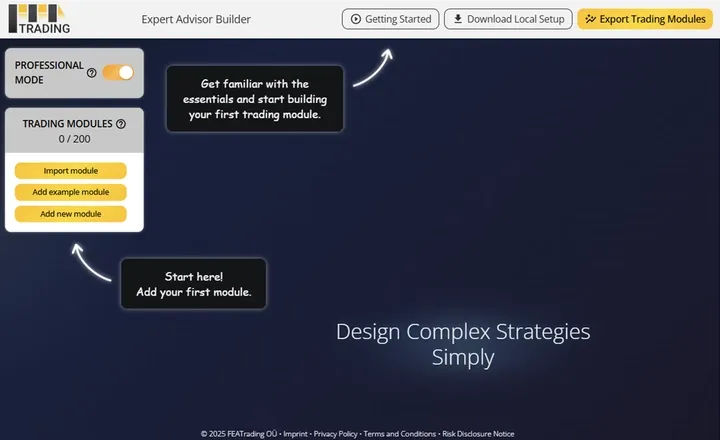
Begin your journey with professional trading software designed for MetaTrader 4 and MetaTrader 5.
The Expert Advisor Builder is available now, and the AI-enhanced features are coming soon. Don’t wait for the future of trading automation - be part of creating it!